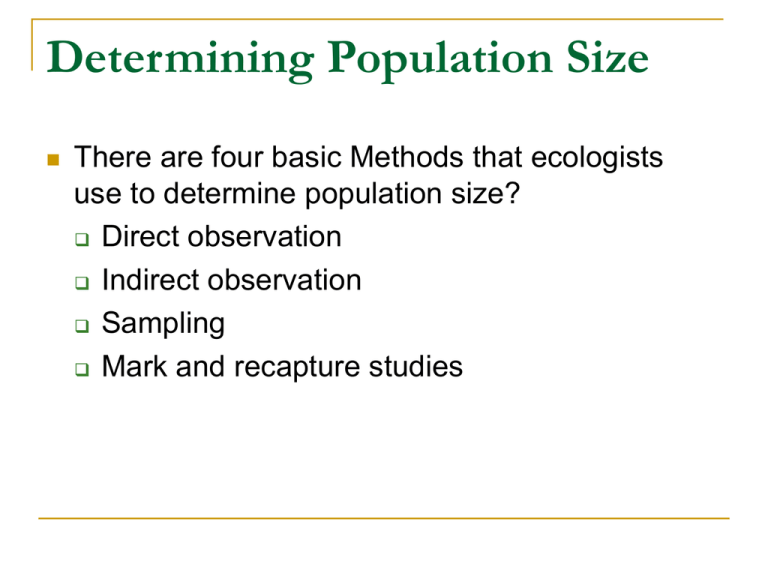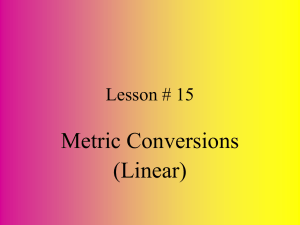Determining Population Size
advertisement

Determining Population Size There are four basic Methods that ecologists use to determine population size? Direct observation Indirect observation Sampling Mark and recapture studies Determining Population Size Determining the size of ant population by knowing the number of ants that inhabit one ant hill, and then observing how many ant hills are in one particular area. Indirect observation Determining Population Size Ecologists estimate the size of the rainbow trout population in a lake by catching a small sample, tagging them and then releasing them. They come back three weeks later and catch another sample noting how many trout have tags, and how many do not. Mark and recapture studies Determining Population Size Determining the number of frogs in a pond by counting all of them individually. Direct Observation Determining Population Size Estimating the number of daisies in a 100 square meter meadow by counting the daisies in a 10 meter by 10 meter plot, and then multiplying by 100. Sampling Putting it all together Direct observation of a population gives you the most accurate count of a population while indirect observation is more of an estimate. Why would an ecologist use indirect observation instead of direct observation. • Because it is not always practical to count all the individuals in a population. Changes in Population Size List 2 ways a population can change in size: When new members join the population 1. _______________________________ When members leave the population 1. _________________________________ Changes in Population Size Birth Rate – Death Rate – Number of deaths in a population over time. Immigration – Number of births in a population over time. New members move into a population. Emigration – Members leave the population. Changes in Population Size Which Two allow a population to increase? – Birth Rate – Immigration Which two allow a population to decrease? – Death Rate – Emigration Changes in Population Size What does the population statement say? If birth rate > death rate, population size increases. If death rate > birth rate, population size decreases. Population Density The number of individuals in a specific area. Population Density = Number of Individuals Unit Area Population Density An ecologist sets out to find out how many red maple trees are in a forest that is 1000 square meters (m2). He marks off a 10 square meter plot and counts 5 red maples in his plot. – Calculate the population density per square meter (m2) in the 10 square meter plot. 5 maples 10 square meters (m2) = 0.5 maples per square meter (m2) Population Density What would be a good estimate of the number of red maples in the entire 1000 square meter forest? 5 maples per 10 square meter x 100 = 500 maples in the forest What method of study did this scientist use to estimate the population size (hint look at the front of this packet)? – Sampling Limiting Factors An environmental factor that causes a population to decrease. – Food and Water – Space – Weather Limiting Factors Pick one of the limiting factors and describe how it limits population growth. Food and Water Space Weather Carrying Capacity The largest population that an area can support. – Determined by the limiting factors that are present. Putting it all together: Study the graph on page E17 in your reading packet and answer the following questions – Over how many years was the population 10 years studied? ________ – In what year did the rabbit population reach it's Year 4 highest point? _________ – What was happening to the population from year 0 to year 4 of the study? Why? • • The population was increasing because more rabbits joined the population than left it. Resources were not limited. In hundreds Analyzing population growth curve of rabbits in a meadow. Human Population – Have we reached carrying capacity?






